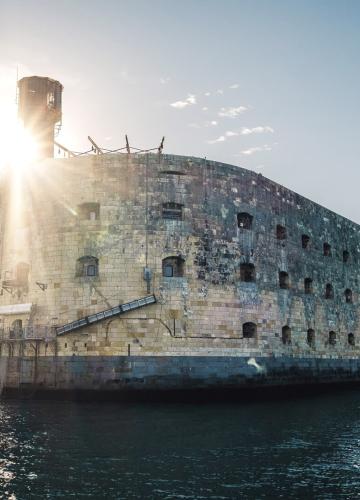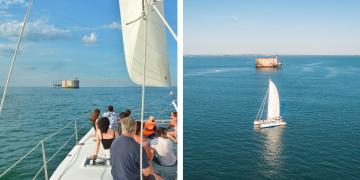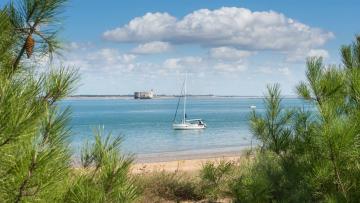
Fort Boyard
Although Fort Boyard is not open to the public, you can still choose from a wide range of boat trips sailing from the île d'Oléron (departures from Port de Saint-Denis d'Oléron or Boyardville) that will get you as close as possible to this imposing ‘stone ship’. The wide choice of boat trips gives you the chance to admire the Chassiron lighthouse or stop off on the île d'Aix, amongst other things.
An ambitious project for its time
Located half-way between the islands of Aix and Oléron, Fort-Boyard was first and foremost designed to protect the anchorage of the île d’Aix and the royal arsenal in Rochefort. The effective range of cannons at that time meant that there was an unprotected gap not covered by the fields of fire of the fort meant to protect the anchorage at Aix and the Saumonards gun battery on Oléron. Between the two islands was a sandbank, the longe de Boyard. Dutch cartographers called this spot ‘Banjaert’, (sandbank in Dutch), from which is derived ‘Boyard’, the name by which it is known today.

Fort Boyard’s construction goes all the way back to the 17th century. From 1666, the building of the arsenal at Rochefort, commissioned by Colbert, meant that this area required additional military protection. France had just come out of the Seven Years’ War with Britain and defending the French coast had become a matter of crucial importance. However, faced with significant technical problems, the idea was postponed multiple times. The great French military engineer Vauban himself declared that he was incapable of overcoming this challenge, saying to Louis XIV: ‘Sire, it would be easier to seize the moon in my teeth than to attempt such a task in this location’.
It wasn’t until the beginning of the 19th century that renewed attempts to make the project a reality were made once more. In 1801, a mixed commission composed of engineers, naval experts and graduates of the Ponts et Chaussées engineering school reported back to Napoleon Bonaparte. This report proposed the construction of what they called a ‘stone ship’ on the Boyard sandbank, putting into practice the theories of military engineer the Marquis de Montalembert as they applied to fortifications. In 1803, First Consul Bonaparte gave the go-ahead for the project. That same year, the stores of provisions that would be needed for the work and the workers’ living quarters were built at the mouth of the chenal de La Perrotine channel on the east coast of the île d’Oléron. This was the origin of the settlement of Boyardville. Work started in 1804, with large stones being piled up upon the sandbank. New quarries were put into operation nearby, notably at the pointe de Coudepont on the île d’Aix. It was a tremendously difficult task, what with stones sinking under their own weight, violent storms and the British military threat.
From shadow into light...
After more than 75,000 m3 of stone had been dumped upon the sandbank, work on the project halted. It began again in 1809, this time on a smaller scale, but work was suspended again during the same year, following a British attack on the French Atlantic fleet anchored in the Aix roads that destroyed several French ships with the help of fireships. To date, 3.5 million francs had already been poured into the project. Thirty years later, in the time of Louis-Philippe, increasing tension between France and the UK gave renewed impetus to the construction of Fort. In 1848, the foundations were completed. The construction of the fort itself would take another ten years. The total cost of the scheme was estimated at almost 3,000,000 francs. The foundations were protected by a ring of Chausey granite. The upper part of the fort was built from Crazannes limestone, the vaulting and interiors out of stone from Saint-Savinien and the embrasures were made of brick. The finishing touch was the look-out post, which was used as a semaphore tower and completed in 1857. Two years later, a breakwater was added to the north and a pier to the south.
Fun fact…the fort is of truly jaw-dropping dimensions - 68 metres long, 32 metres wide and 20 metres high. It was to have been garrisoned by 250 soldiers and equipped with 74 cannons – as many as a three-decker warship. However, in the end, only around 30 cannons were fitted.

By the middle of the 19th century, improvements in artillery (rifled cannons, the replacement of cannonballs by shells) rendered the fort, which had only just been completed, obsolete, the gap in the fields of fire between Oléron and Aix having been closed. At the end of the Second Empire period, the fort was used to hold Prussian and Austrian prisoners-of-war. Later on, it was used as a prison for Communards, with Louise Michel and Henri Rochefort held here before their transfer to the penal colony of New Caledonia.
By the beginning of the 20th century, the abandoned fort had been stripped of anything of value. In 1950, it was added to the registry of listed buildings. It was bought at auction in 1962 by a member of the public from the French public estate for 7,500 francs. In 1967, it acted as a backdrop for the film ‘Les aventuriers’ (the Last Adventure) by Robert Enrico, starring Lino Ventura and Alain Delon. The French game show producer Jacques Antoine filmed the pilot of the game show ‘La chasse aux trésors’ (Treasure Hunt) hosted by Philippe Gildas and Philippe de Dieuleveult here. It was aired on television on September 6th, 1981. Jacques Antoine finally bought the fort in 1988 for 1.5 million francs and sold it for the symbolic sum of one franc to the Conseil Général de Charente-Maritime, whilst retaining exclusive rights to use the location. Jacques Antoine, Jean-Pierre Mitrecey and Pierre Launay devised the game show ‘Les clés de Fort Boyard’. The first episode aired on July 7th, 1990, and the concept was subsequently sold to thirty countries, making Fort Boyard instantly recognized the world over. It seems like a fitting reversal of fortune for a project that for many years had been dubbed ‘le Fort de l’inutile’ (the useless fort)!